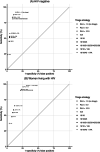Comparison of human papillomavirus-based cervical cancer screening strategies in Tanzania among women with and without HIV
- PMID: 36093587
- PMCID: PMC10087897
- DOI: 10.1002/ijc.34283
Comparison of human papillomavirus-based cervical cancer screening strategies in Tanzania among women with and without HIV
Abstract
Cervical cancer is the most common female cancer in Eastern Africa, and the World Health Organization (WHO) recommends human papillomavirus (HPV)-based screening as a key element to eliminate the disease. In this cross-sectional study from Tanzania, we compared nine HPV-based cervical cancer screening strategies, including HPV testing at standard cut-off; HPV testing at increased viral load cut-offs; HPV testing with partial/extended genotyping, and HPV testing with visual inspection with acetic acid (VIA). We pooled data collected during 2008 to 2009 and 2015 to 2017 from 6851 women aged 25 to 65. Cervical cytology samples were HPV tested with Hybrid Capture 2, and HPV positive samples were genotyped with INNO-LiPA Extra II. Human immunodeficiency virus (HIV) testing and VIA were done according to local standards. We calculated sensitivity, specificity, positive and negative predictive value of screening strategies, with high-grade cytological lesions as reference, separately for women with and without HIV. HPV testing at standard cut-off (1.0 relative light units [RLU]) had highest sensitivity (HIV+: 97.8%; HIV-: 91.5%), but moderate specificity (HIV+: 68.1%; HIV-: 85.7%). Increasing the cut-off for HPV positivity to higher viral loads (5.0/10.0 RLU) increased specificity (HIV+: 74.2%-76.5%; HIV-: 89.5%-91.2%), with modest sensitivity reductions (HIV+: 91.3%-95.7%; HIV-: 83.5%-87.8%). Limiting test positivity to HPV types 16/18/31/33/35/45/52/58 improved specificity while maintaining high sensitivity (HIV+: 90.2%; HIV-: 81.1%). Triage with VIA and/or partial genotyping for HPV16/18 or HPV16/18/45 had low sensitivities (≤65%). In conclusion, HPV testing alone, or HPV testing with extended genotyping or increased viral load cut-offs, may improve cervical cancer screening in Sub-Saharan Africa.
Keywords: Africa; cervical cancer; human papillomavirus; prevention; screening.
© 2022 The Authors. International Journal of Cancer published by John Wiley & Sons Ltd on behalf of UICC.
Conflict of interest statement
Crispin Kahesa, Louise T. Thomsen, Ditte S. Linde, Bariki Mchome, Johnson Katanga, Patricia Swai, Rachel Manongi, Myassa Kjaerem, Marianne Waldstrøm, Julius Mwaiselage and Vibeke Rasch report no potential conflicts of interest. Susanne K. Kjær reports that she previously received research grants from Merck through the affiliating institution. Thomas Iftner reports that his hosting institution received research grants from Hologic Inc and Becton Dickinson.
Figures


Similar articles
-
Performance of visual inspection, partial genotyping, and their combination for the triage of women living with HIV who are screen positive for human papillomavirus: Results from the AIMA-CC ANRS 12375 multicentric screening study.Int J Cancer. 2025 Feb 1;156(3):598-607. doi: 10.1002/ijc.35190. Epub 2024 Sep 25. Int J Cancer. 2025. PMID: 39319557 Free PMC article.
-
Performance of visual inspection with acetic acid and human papillomavirus testing for detection of high-grade cervical lesions in HIV positive and HIV negative Tanzanian women.Int J Cancer. 2014 Aug 15;135(4):896-904. doi: 10.1002/ijc.28712. Epub 2014 Feb 4. Int J Cancer. 2014. PMID: 24391021
-
Performance of carcinogenic human papillomavirus (HPV) testing and HPV16 or HPV18 genotyping for cervical cancer screening of women aged 25 years and older: a subanalysis of the ATHENA study.Lancet Oncol. 2011 Sep;12(9):880-90. doi: 10.1016/S1470-2045(11)70188-7. Epub 2011 Aug 22. Lancet Oncol. 2011. PMID: 21865084 Clinical Trial.
-
Evidence regarding human papillomavirus testing in secondary prevention of cervical cancer.Vaccine. 2012 Nov 20;30 Suppl 5:F88-99. doi: 10.1016/j.vaccine.2012.06.095. Vaccine. 2012. PMID: 23199969 Review.
-
The East Africa Consortium for human papillomavirus and cervical cancer in women living with HIV/AIDS.Ann Med. 2022 Dec;54(1):1202-1211. doi: 10.1080/07853890.2022.2067897. Ann Med. 2022. PMID: 35521812 Free PMC article. Review.
Cited by
-
Performance of visual inspection, partial genotyping, and their combination for the triage of women living with HIV who are screen positive for human papillomavirus: Results from the AIMA-CC ANRS 12375 multicentric screening study.Int J Cancer. 2025 Feb 1;156(3):598-607. doi: 10.1002/ijc.35190. Epub 2024 Sep 25. Int J Cancer. 2025. PMID: 39319557 Free PMC article.
-
Improving the Sensitivity-Specificity Balance of Human Papillomavirus Testing on Self- and Clinician-Collected Samples in South Africa.JCO Glob Oncol. 2025 Apr;11:e2500037. doi: 10.1200/GO-25-00037. Epub 2025 Apr 28. JCO Glob Oncol. 2025. PMID: 40294360 Free PMC article.
-
Triage of HPV positivity in a high HIV prevalence setting: A prospective cohort study comparing visual triage methods and HPV genotype restriction in Botswana.Int J Gynaecol Obstet. 2024 May;165(2):507-518. doi: 10.1002/ijgo.15225. Epub 2023 Nov 10. Int J Gynaecol Obstet. 2024. PMID: 37950533 Free PMC article. Clinical Trial.
-
State of the science and future directions for research on HIV and cancer: Summary of a joint workshop sponsored by IARC and NCI.Int J Cancer. 2024 Feb 15;154(4):596-606. doi: 10.1002/ijc.34727. Epub 2023 Sep 15. Int J Cancer. 2024. PMID: 37715370 Free PMC article. Review.
References
-
- Ferlay J, Ervik M, Lam F, et al. Global Cancer Observatory: Cancer Today. Fact Sheet, Cervix Uteri. Lyon, France: International Agency for Research on Cancer; 2020.
-
- World Health Organization . WHO Guidelines for Screening and Treatment of Precancerous Lesions for Cervical Cancer Prevention. 2nd ed. Geneva: WHO; 2021. - PubMed
-
- Tota JE, Bentley J, Blake J, et al. Introduction of molecular HPV testing as the primary technology in cervical cancer screening: acting on evidence to change the current paradigm. Prev Med. 2017;98:5‐14. - PubMed

